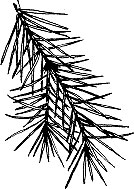Needled evergreens, often known as narrow-leaved evergreens or conifers, are planted primarily because of their evergreen foliage. But the many sizes, shapes and colors available also contribute to their popularity.
Conifers range in size from prostrate plants growing only a few inches tall to large trees. Shapes include flat, groundcover types, horizontal spreaders, upright pyramidal forms, and even weeping and contorted shapes. Foliage color ranges from a gold and cream variegation to all shades of green, gray-green and blue-green.
Poorly drained soil, planting too deeply and winter drying are the most common causes of damage or death of needled evergreens. Most are killed easily by water standing at their roots. They must be planted in well-drained soil. A raised bed may be the solution for planting on excessively wet sites.
Plant an evergreen with the ball of soil an inch or two higher than it grew in the nursery. Dig the planting hole at least 1 foot wider in diameter than the soil ball. After the plant has been put in position, backfill around it with good topsoil. If good topsoil is not available, mix 25 percent peatmoss, compost or similar organic material with the existing soil to provide a suitable substitute.
Winter drying is a problem of all evergreens. The evergreen foliage may lose moisture in the winter when cold or frozen soils make it difficult for roots to replace moisture as fast as it is lost. If the summer or fall has been dry, thoroughly soak the area around the plants in late November so the plants go into winter with an adequate moisture supply to help prevent the problem. Less winter-hardy evergreens should be planted in areas protected from winter sun and wind to prevent winter damage and ensure their survival.
Evergreens are sold either balled-and-burlapped or in containers. The burlap may be left on the ball for planting. Loosen the burlap from around the trunk and tuck it under the sides of the ball. Be especially careful to remove any string or wire wrapped around the stem. Metal or plastic containers must be removed before planting.
Fertilizing at planting time may injure new roots. Do not fertilize evergreens until they have had at least one growing season to become established. Plants that have good color and are making satisfactory growth probably don't need fertilizer. Plants weakened by insects, diseases, poor drainage or infertile soil may respond to fertilizer. If fertilizer is necessary, it should be applied between mid-October and mid-March.
The conifers commonly grown in Missouri can be divided into the nine groups described in the following sections.
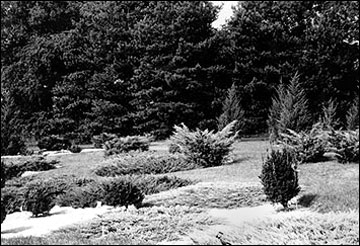 Needled evergreens come in many shapes and sizes.
Needled evergreens come in many shapes and sizes.
Pine
 The pines can be easily distinguished from other evergreens because their needle-like leaves are produced in bundles of two to five needles. Pines are used for screens, windbreaks and mass plantings or are planted as specimen trees. They need full sunlight to develop properly.
The pines can be easily distinguished from other evergreens because their needle-like leaves are produced in bundles of two to five needles. Pines are used for screens, windbreaks and mass plantings or are planted as specimen trees. They need full sunlight to develop properly.
Many species of pine can be grown in Missouri. However, the five species described in the following section are the ones most commonly grown as ornamentals. Four of these species grow to be large trees. The other (mugo pine) is a shrub.
White pine (Pinus strobus)
The delicate, soft, light bluish-green foliage of the white pine makes an attractive evergreen tree. It is easily recognized because it is the only commonly grown five-needled pine. White pine is easily transplanted and fast growing. Since it will become a large tree, it needs adequate room to develop properly.
On favorable sites, white pine sometimes grows too fast to retain its dense foliage. This can be avoided by pruning the tree to increase its density. However, in pruning white pine, note that needles are not produced evenly along the stem but are clustered near the tip. When the tip is cut back, some needles must be left on the remaining portion or the twig will die back to last year's growth.
White pine is sensitive to air pollution. Therefore it is not a good choice for planting in city conditions.
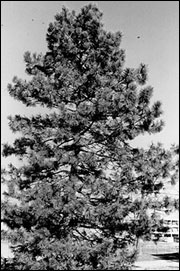 Austrian pine (Pinus nigra)
Austrian pine (Pinus nigra)
The long, stiff needles of Austrian pine are produced in bundles of two. They are a deep, dark green color that makes the plant excellent to use as a background for small trees with colorful flowers or ornamental fruit. Austrian pine develops into a large tree and needs adequate room for growth. It is relatively resistant to air pollutants and will grow on a wide range of soil types. However, it is susceptible to a serious fungal tip blight disease.
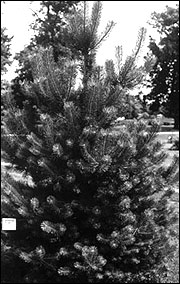 Scotch pine (Pinus sylvestris)
Scotch pine (Pinus sylvestris)
Scotch pines can be recognized by their short, twisted needles that are produced in bundles of two. They are commonly grown for Christmas trees. Young scotch pines have a symmetrical pyramidal shape, but they develop an open picturesque growth habit as they mature. Mature specimens develop a reddish orange flaking bark on upper branches. Scotch pines are susceptible to a fatal diseased called pine wilt. It is also commonly affected by pine needle scale and needle blights.
Japanese black pine (Pinus thunbergi)
Japanese black pine produces its stiff, dark green, 3- to 5-inch-long needles in bundles of two. Its large, grayish-white terminal buds help distinguish it from most other pines.
The popularity of Japanese black pine has increased during the past few years, primarily because of its informal growth habit. This irregular growth habit makes it a good accent or specimen plant for use in informal landscapes but does not make it well suited for mass plantings. In Japan, forests of this pine species have been susceptible to pine wilt disease.
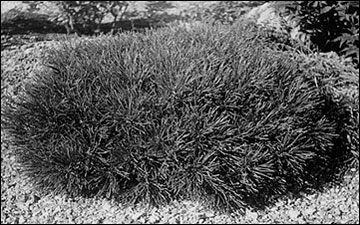 Mugo pine (Pinus mugo)
Mugo pine (Pinus mugo)
Mugo pine is a shrub with a dense, rounded growth habit. It is an excellent small evergreen shrub. Plants of Mugo pine show a wide variation in shape and vigor. The compact types with many stems are the most desirable. Because of its variability, it is more desirable when grown as a single plant rather than in masses. Pruning may be necessary to maintain its desirable growth habit. Mugo pine is susceptible to pine needle scale.
Spruce
The needle-like foliage of the spruces is four-angled in cross section, not flat as with most conifers that produce their needles singly. Spruces can be recognized by the persistent leaf bases that remain on the twigs after the needles have fallen.
Spruces are native to cool climates and therefore are poorly adapted for growing in most of Missouri. They should be planted only on well-drained soils. Young trees are attractive with their dense foliage and symmetrical growth habit. The four spruces described in the following section are the ones most commonly available in the nursery trade.
Norway spruce (Picea abies)
Norway spruce is one of the fastest growing of all the spruces. As the tree grows older, the side branches become horizontal with a slight upturn at the tip. Secondary branches hang downward from the main branches, giving the tree a graceful appearance. The large cones (4 to 6 inches long), largest of any of the spruces, are an added attraction in years when they are produced.
Black Hills spruce (Picea glauca densata)
Black Hills spruce, a slow-growing, compact cultivar, is one of the hardiest of the spruces. Its dense green to bluish green foliage is its most ornamental character.
Dwarf Alberta spruce (Picea glauca 'Conica')
The dwarf Alberta spruce is a miniature conical shaped tree. It grows very slowly and seldom needs pruning. The bright green, dense foliage makes it attractive. Its maximum size under Missouri conditions seldom exceeds 4 to 5 feet. Alberta spruce is primarily a novelty specimen plant and seldom is used in basic landscaping. The plant is commonly affected by mites, especially when planted under eaves, where they are sheltered from rainfall.
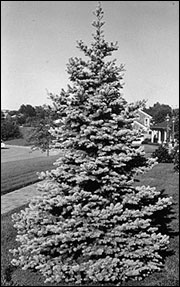 Colorado blue spruce (Picea pungens)
Colorado blue spruce (Picea pungens)
The blue spruce is one of the strongest accent plants we have. Because of its stiff growth habit and unusual color, it stands out wherever it is planted. Placing this tree in a landscape is difficult because it is so dominant. It is best used as a single specimen for accent. A blue spruce grows slower than green types and usually commands a higher price. It is one of the most difficult conifers to grow in our soils and climate. It is susceptible to several fungal diseases.
Fir
The flat needles of firs leave a round, flat scar when they fall from the twig. The cones of firs are borne in an erect position, while those of most other conifers hang downward. Concolor fir, described below, is the only fir commonly grown in Missouri.
Concolor or white fir (Abies concolor)
The concolor fir is similar to blue spruce in foliage color and general form of the tree. It is adapted to the northern one-third of the state. Because of its greater insect and disease resistance, it may be preferable to blue spruce. We do not generally recommend it for other regions of the state.
Douglas fir (Pseudotsuga Menziesi)
Douglas fir is not a true fir. It belongs to an entirely different genus. A Douglas fir can be most easily recognized by its long pointed buds and its unique cones that have a forked, papery bract sticking out from between the scales. The flat needles are grooved on the upper surface with a white band on either side of a prominent midrib beneath. Douglas fir is not adapted to Missouri conditions except in deep, well-drained soils.
Hemlock
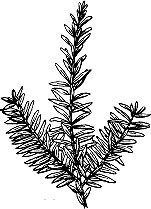 Hemlock can be recognized by its short, flat needles with narrow white stripes on the underside. Its small cones are only about one-half inch long. Only one species of hemlock is commonly grown in Missouri.
Hemlock can be recognized by its short, flat needles with narrow white stripes on the underside. Its small cones are only about one-half inch long. Only one species of hemlock is commonly grown in Missouri.
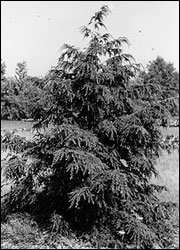 Canada hemlock (Tsuga canadensis)
Canada hemlock (Tsuga canadensis)
Hemlock is one of the most graceful and beautiful of the needled evergreen trees, but it needs moist, well-drained soil to develop properly. It prefers partial shade and should be protected from the wind. It is easy to transplant but requires a good soil. Hemlock will withstand close shearing and is one of the better needled evergreens for growing as a hedge.
Chamaecyparis, false cypress
Chamaecyparis, or false cypresses, are variable evergreens. Both tree and shrub forms are available in a wide variety of foliage colors. They are native to moist climates and therefore are not well adapted to Missouri conditions.
Chamaecyparis should be planted in protected locations and in limited quantities on a trial basis rather than as extensive permanent plantings. We do not recommend them for general landscape use.
Cedrus — the true cedars
Cedrus, or true cedars, make outstanding landscape plants where they are hardy. In Missouri, they should be planted only in protected locations, except in the southern third of the state. The needle-like evergreen foliage of true cedars usually is produced in bunches near the terminals of branches. Cones of true cedars are borne upright on the upper side of branches.
Because the hardier forms of cedrus are relatively slow growing and somewhat difficult to transplant, they are not commonly available in nurseries.
Yew
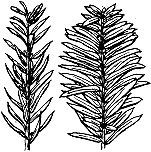 Yews are the most popular evergreens being planted in Missouri. Their flattened, needle-like leaves are the darkest green and the most ornamental of all the needled evergreen shrubs. Their fleshy red fruit, ability to grow in shade and lack of serious insect or disease pests also contribute to their popularity. Seeds and foliage are toxic to humans and livestock.
Yews are the most popular evergreens being planted in Missouri. Their flattened, needle-like leaves are the darkest green and the most ornamental of all the needled evergreen shrubs. Their fleshy red fruit, ability to grow in shade and lack of serious insect or disease pests also contribute to their popularity. Seeds and foliage are toxic to humans and livestock.
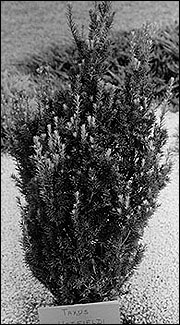 The sexes are separate in yews. Male flowers are produced on one plant and the female flowers on another. Only female plants produce the attractive berries, but both sexes need to be present to ensure fruit production. One male plant is generally sufficient to pollinate six to eight female plants.
The sexes are separate in yews. Male flowers are produced on one plant and the female flowers on another. Only female plants produce the attractive berries, but both sexes need to be present to ensure fruit production. One male plant is generally sufficient to pollinate six to eight female plants.
Yews will withstand almost any exposure and will grow in any reasonably good garden soil that has good drainage. They prefer a shaded or partially shaded planting site with a moist, well-drained soil. Direct sunlight and strong winds may injure the foliage in winter.
Among the yews grown as ornamentals, the English yew (Taxus baccata) is the most ornamental, but the Japanese yew (Taxus cuspidata) is the hardiest. Most ornamental varieties grown in Missouri are forms of the intermediate yew (Taxus x media), also known as Anglojap yew, which is a hybrid of the two species mentioned above.
The many varieties of yew can be divided into three groups: upright, globe-shaped and spreading. Upright yews are usually less than half as wide as they are tall. Globe-shaped or rounded ones are about the same width as height. Spreading yews are two to three times as wide as they are tall. Some of the most commonly grown cultivars are listed in Table 1.
Arborvitae
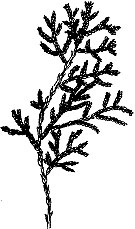
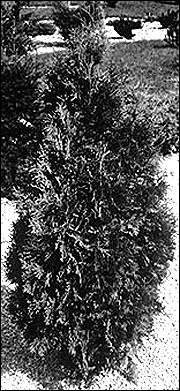 Arborvitae has flattened, scale-like needles with rounded edges. Its seed is produced in small cones. It is an easily propagated, fast-growing plant that is commonly sold in the spring of the year at discount prices. Arborvitae can be injured seriously by late spring frosts and by winter drying. It tends to be a relatively short-lived plant.
Arborvitae has flattened, scale-like needles with rounded edges. Its seed is produced in small cones. It is an easily propagated, fast-growing plant that is commonly sold in the spring of the year at discount prices. Arborvitae can be injured seriously by late spring frosts and by winter drying. It tends to be a relatively short-lived plant.
Juniper
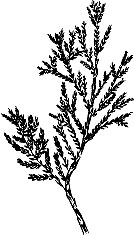 Junipers have sharp, pointed, scale-like foliage. Their fruit is a fleshy blue berry. The sexes are separate, and only female plants produce berries.
Junipers have sharp, pointed, scale-like foliage. Their fruit is a fleshy blue berry. The sexes are separate, and only female plants produce berries.
Junipers are among the best adapted and hence the most commonly grown evergreens in Missouri. They withstand hot, dry, poor soils better than other evergreens. Junipers need full sun for best development. None of the junipers will grow on wet, poorly drained soil or in heavy shade.
There are hundreds of varieties of juniper from which to choose; they come in all sizes and shapes. The color varies from yellow-green to green, blue-green, gray-green or silver. Because so many varieties of juniper have been grown, many of the names have become confused. For landscape purposes we can divided them into three major groups: prostrate, spreading, and upright. The varieties described here are the ones most commonly available.
The prostrate, or creeping junipers, are low-growing plants used primarily as groundcovers. They seldom grow over 18 inches high and will spread over a large area. The foliage of many prostrate junipers changes color during winter. The summer and winter foliage colors and sizes of some common prostrate juniper cultivars are given in Table 2.
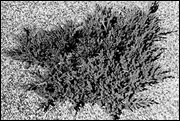 Creeping juniper
Creeping juniper
Table 2
The approximate sizes and foliage colors of some common prostrate junipers
| Cultivar | Height | Spread | Summer color | Winter color |
|---|---|---|---|---|
| Andorra | 18 inches | 5 to 8 feet | light green | plum |
| Bar Harbor | 10 inches | 6 to 8 feet | gray green | slate |
| Blue Chip | 8 inches | 5 to 8 feet | blue | blue |
| Blue Rug | 6 inches | 6 to 8 feet | blue | blue |
| Procumbens | 10 inches | 6 to 8 feet | blue-green | blue-green |
| San Jose | 10 inches | 6 to 7 feet | gray-green | gray-green |
| Sargent (green) | 10 inches | 6 to 7 feet | green | green |
| Sargent (blue) | 18 inches | 6 to 7 feet | blue | blue |
| Turquoise spreader | 6 inches | 6 to 8 feet | green | green |
 Pfitzer juniper.
Pfitzer juniper.
Spreading junipers can be divided into two groups. The first group has a horizontal growth habit that gives the plant a flat-topped appearance. Branches on the second type have an arching pattern of growth that makes a more vase-shaped plant. The approximate sizes of some of the most commonly grown cultivars of spreading juniper are shown in Table 3. Most spreading junipers retain the same foliage color year-round.
Table 3
The approximate sizes and foliage colors of some spreading cultivars of junipers
| Cultivar | Height | Spread | Foliage color |
|---|---|---|---|
| Compact Pfitzer | 3 feet | 6 feet | green |
| Blue Pfitzer | 3 feet | 6 feet | blue |
| Armstrong | 4 feet | 6 feet | blue-green |
| Hetz | 8 feet | 8 feet | light blue |
| Arkadia | 2 feet | 5 feet | green |
| Old Gold | 3 feet | 5 feet | yellow-green |
Most upright junipers are actually grown as shrubs. Unless they are heavily sheared, they will quickly outgrow their intended use. To develop their natural beauty, they need to be planted where they have plenty of room to grow. The foliage color of most upright junipers does not change with the seasons. Colors of some of the most common cultivars are given in Table 4.
Table 4
Foliage colors of some common cultivars of upright junipers
| Cultivar | Foliage color |
|---|---|
| Blue Heaven | powder blue |
| Burki | blue |
| Canaertii | blue-green |
| Keteleeri | green |
| Wichita Blue | light blue |
| Skyrocket | green |
Many varieties of juniper are available in nurseries, and new ones are always being developed. The lists in Tables 2, 3 and 4 are just a few of the more commonly available cultivars. You will find many others; some may be adapted better to your area than the ones listed.

